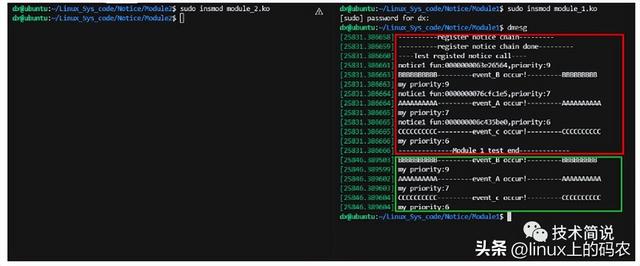举个形象的例子:将通知链比喻成”订阅者-发布者“,订阅者将感兴趣的公众号关注并设置提醒,发布者一旦发布某个文章,订阅者即可收到通知看到发布的内容。
在Linux内核中为了及时响应某些到来的事件,采取了通知链机制。该机制的两个角色的任务:
1、通知者定义通知链
2、被通知者向通知链中注册回调函数
3、当事件发生时,通知者发送通知 (执行通知链上每个调用块上的回调函数)所以通知链是一个单链表,单链表上的节点是调用块,每个调用块上有事件相关的回调函数和调用块的优先级。当事件触发时会按优先级顺序执行该链表上的回调函数。通知链只用于各个子系统之间,不能用于内核和用户空间进行事件的通知。
二、相关细节1、通知链的类型
原子通知链( Atomic notifier chains ):
通知链元素的回调函数(当事件发生时要执行的函数)只能在中断上下文中运行,不允许阻塞。
可阻塞通知链( Blocking notifier chains ):
通知链元素的回调函数在进程上下文中运行,允许阻塞。
原始通知链( Raw notifier chains ):
对通知链元素的回调函数没有任何限制,所有锁和保护机制都由调用者维护。
SRCU 通知链( SRCU notifier chains ):可阻塞通知链的一种变体
本文将以原子通知链进行分析
2、原子通知链与通知块
struct raw_notifier_head {
struct notifier_block __rcu *head;
};
初始化一个原子通知链使用以下宏定义
#define RAW_NOTIFIER_HEAD(name) \
struct raw_notifier_head name = \
RAW_NOTIFIER_INIT(name)
#define RAW_NOTIFIER_INIT(name) { \
.head = NULL }
例如创建一个设备通知链队列头:
RAW_NOTIFIER_HEAD(netdev_chain)
struct raw_notifier_head就相当于存放这条通知链单链表头,每一个通知链上的元素也就是通知块如下定义:
struct notifier_block {
notifier_fn_t notifier_call; //通知调用的函数
struct notifier_block __rcu *next;//指向下一个通知节点,从而形成链队
int priority;//优先级,会根据优先级在单链表中排序
};
回调函数接口:
typedef int (*notifier_fn_t)(struct notifier_block *nb,
unsigned long action, void *data);
整个通知链的组织如下图所示:

3、向通知链中插入通知块
int raw_notifier_chain_register(struct raw_notifier_head *nh,
struct notifier_block *n)
{
return notifier_chain_register(&nh->head, n);
}
static int notifier_chain_register(struct notifier_block **nl,
struct notifier_block *n)
{
//循环遍历通知链
while ((*nl) != NULL) {
if (n->priority > (*nl)->priority)//按照优先级插入通知链表
break;
nl = &((*nl)->next);
}
n->next = *nl;
rcu_assign_pointer(*nl, n);
return 0;
}
4、调用通知链
int raw_notifier_call_chain(struct raw_notifier_head *nh,
unsigned long val, void *v)
{
return __raw_notifier_call_chain(nh, val, v, -1, NULL);
}
int __raw_notifier_call_chain(struct raw_notifier_head *nh,
unsigned long val, void *v,
int nr_to_call, int *nr_calls)
{
return notifier_call_chain(&nh->head, val, v, nr_to_call, nr_calls);
}
static int notifier_call_chain(struct notifier_block **nl,
unsigned long val, void *v,
int nr_to_call, int *nr_calls)
{
int ret = NOTIFY_DONE;
struct notifier_block *nb, *next_nb;
nb = rcu_dereference_raw(*nl);
//循环遍历调用链上的调用块
while (nb && nr_to_call) {
next_nb = rcu_dereference_raw(nb->next);
#ifdef CONFIG_DEBUG_NOTIFIERS
if (unlikely(!func_ptr_is_kernel_text(nb->notifier_call))) {
WARN(1, "Invalid notifier called!");
nb = next_nb;
continue;
}
#endif
//执行该调用块的回调函数
ret = nb->notifier_call(nb, val, v);
if (nr_calls)
(*nr_calls) ;
//如果该调用块的回调函数返回值为NOTIFY_STOP_MASK则跳出调用链的遍历,也就不执行后面的调用块的回调函数了
if (ret & NOTIFY_STOP_MASK)
break;
nb = next_nb;
nr_to_call--;
}
return ret;
}
更多LINUX内核视频教程文档资料免费领取后台私信【内核】自行获取.


Linux内核源码/内存调优/文件系统/进程管理/设备驱动/网络协议栈-学习视频教程-腾讯课堂
三、编写内核模块进行实验1、案例1
编写内核模块作为被通知者,向内核netdev_chain通知链中插入自定义通知块(在通知块中自定义事件触发的回调函数),源码如下:
#include <linux/module.h>
#include <linux/init.h>
#include <linux/kernel.h>
#include <linux/types.h>
#include <linux/netdevice.h>
#include <linux/inetdevice.h>
//处理网络设备的启动与禁用等事件
int test_netdev_event(struct notifier_block *this, unsigned long event, void *ptr)
{
struct net_device *dev = (struct net_device *)ptr;
switch(event)
{
case NETDEV_UP:
if(dev && dev->name)
printk("dev[%s] is up\n",dev->name);
break;
case netDEV_DOWN:
if(dev && dev->name)
printk("dev[%s] is down\n",dev->name);
break;
default:
break;
}
return NOTIFY_DONE;
}
struct notifier_block devhandle={
.notifier_call = test_netdev_event
};
static int __init test_init(void)
{
/*
在netdev_chain通知链上注册消息块
netdev_chain通知链是内核中用于传递有关网络设备注册状态的通知信息
*/
register_netdevice_notifier(&devhandle);
return 0;
}
static void __exit test_exit(void)
{
unregister_netdevice_notifier(&devhandle);
return;
}
module_init(test_init);
module_exit(test_exit);
MODULE_LICENSE("GPL");
Makefile:
obj-m:=Demo.o
CURRENT_PATH:=$(shell pwd)
LINUX_KERNEL:=$(shell uname -r)
LINUX_KERNEL_PATH:=/usr/src/linux-headers-$(LINUX_KERNEL)
all:
make -C $(LINUX_KERNEL_PATH) M=$(CURRENT_PATH) modules
clean:
make -C $(LINUX_KERNEL_PATH) M=$(CURRENT_PATH) clean
将模块插入内核后,将网卡关闭再重启一次,查看日志信息:
dx@ubuntu:~/Linux_Sys_code/Notice/Module3$sudo insmod Demo.ko
dx@ubuntu:~/Linux_Sys_code/Notice/Module3$ dmesg
[24309.137937] inet[00000000baf272e6] is down
[24313.046209] inet[00000000baf272e6] is up
2、案例2
通过写两个内核模块,其中一个作为通知者一个作为被通知者
module_1.c:
- 初始化一个通知链
- 定义事件的回调函数并向通知链中插入三个通知块(与之前定义的回调函数相对应)
- 测试通知链:循环遍历通知链的通知块,并同时调用对应的回调函数
#include <linux/init.h>
#include <linux/module.h>
#include <linux/kernel.h>
#include <linux/notifier.h>
/*
模块功能:1、初始化一个通知链
2、定义事件的回调函数并向通知链中插入三个通知块(与之前定义的回调函数相对应)
3、测试通知链:循环遍历通知链的通知块,并同时调用对应的回调函数
*/
static RAW_NOTIFIER_HEAD(test_chain_head);
EXPORT_SYMBOL_GPL(test_chain_head);
//通知块1的执行函数
static int A_call(struct notifier_block *nb, unsigned long event, void *v)
{
printk("AAAAAAAAAA---------event_A occur!---------AAAAAAAAAA\n");
printk("my priority:%d\n",nb->priority);
return NOTIFY_DONE;
}
//通知块1:testA
static struct notifier_block testA = {
.notifier_call = A_call,
.priority = 7,
};
//通知块2的执行函数
static int B_call(struct notifier_block *nb, unsigned long event, void *v)
{
printk("BBBBBBBBBB---------event_B occur!---------BBBBBBBBB\n");
printk("my priority:%d\n",nb->priority);
return NOTIFY_STOP_MASK;
}
//通知块2:testB
static struct notifier_block testB = {
.notifier_call = B_call,
.priority = 9,
};
//通知块1的执行函数
static int C_call(struct notifier_block *nb, unsigned long event, void *v)
{
printk("CCCCCCCCCC---------event_c occur!---------CCCCCCCCCC\n");
printk("my priority:%d\n",nb->priority);
return NOTIFY_DONE;
}
static struct notifier_block testC = {
.notifier_call = C_call,
.priority = 6,
};
static int __init my_register(void)
{
printk("----------register notice chain---------\n");
raw_notifier_chain_register(&test_chain_head,&testA);
raw_notifier_chain_register(&test_chain_head,&testB);
raw_notifier_chain_register(&test_chain_head,&testC);
printk("----------register notice chain done---------\n");
//遍历已经注册的调用链
struct notifier_block *nb, *next_nb;
struct raw_notifier_head *tmp = &test_chain_head;
struct notifier_block *head = tmp->head;
nb = rcu_dereference_raw(head);
printk("----Test registed notice call----\n");
//循环遍历调用链,测试一下所插入的通知块
while (nb) {
int ret = NOTIFY_DONE;
int index=0;
next_nb = rcu_dereference_raw(nb->next);
printk("notice%d fun:%p,priority:%d", index,nb->notifier_call,nb->priority);
ret = nb->notifier_call(nb, 1, NULL); //调用注册的回调函数
nb = next_nb;
}
printk("--------------Module_1 test end-------------\n");
return 0;
}
static void __exit my_unregister(void)
{
raw_notifier_chain_unregister(&test_chain_head,&testA);
raw_notifier_chain_unregister(&test_chain_head,&testB);
raw_notifier_chain_unregister(&test_chain_head,&testC);
}
module_init(my_register);
module_exit(my_unregister);
MODULE_AUTHOR("Dong Xu");
MODULE_LICENSE("GPL");
module_2.c:模拟某事件发生,并调用通知链
#include <linux/init.h>
#include <linux/module.h>
#include <linux/kernel.h>
#include <linux/notifier.h>
/*
模块功能:模拟某事件发生,并调用通知链.
*/
extern struct raw_notifier_head test_chain_head;
//某事件
static int event(unsigned long val)
{
int ret = raw_notifier_call_chain(&test_chain_head,val,NULL);
return notifier_to_errno(ret);
}
static int __init my_entry(void)
{
event(666);//模拟某事件发生
return 0;
}
static void __exit my_exit(void)
{
printk("test end\n");
}
module_init(my_entry);
module_exit(my_exit);
MODULE_AUTHOR("Dong Xu");
MODULE_LICENSE("GPL");
(module_1与module_2的Makefile可参考上面的Demo1)
运行时先插入module_1再插入module_2结果如下,红框内是module_1中的测试输出日志,绿框内为世界调用通知链时的执行结果日志。

从上面可以看到通知链的执行顺序是按照优先级进行的,那么当调用通知链时是否每个通知块上的回调函数都会执行呢?
答案:不是,每个被执行的notifier_block回调函数的返回值可能取值以下几个:
- NOTIFY_DONE:表示对相关的事件类型不关心。
- NOTIFY_OK:顺利执行。
- NOTIFY_BAD:执行有错。
- NOTIFY_STOP:停止执行后面的回调函数。
- NOTIFY_STOP_MASK:停止执行的掩码
如当返回值NOTIFY_STOP_MASK会停止执行后面优先级低的调用块的函数。
例如把module_1中通知块的回调函数B_call的返回值修改为NOTIFY_STOP_MASK后,重新编译,运行结果如下,只执行了调用链中调用块2的回调函数。

转载地址:Linux内核基础 | 通知链机制 - Linux内核 - 我爱内核网 - 构建全国最权威的内核技术交流分享论坛






